This year autumn is slow in coming. Often by the end of September, the hills are as colourful as the big box of Crayola crayons I always begged (unsuccessfully) my mother to buy, with trees standing in ranges of red, orange and pink, gold and chartreuse, and occasional patches of dark wintery green.
Not this year. Temperatures have remained high and leaves seem reluctant to lose their grip on summer. In the woods and fields around Glen Villa, though, wildflowers appropriate to the season are blooming their hearts out.
Asters predominate. Most are purple, some are white — and often they grow one beside another.
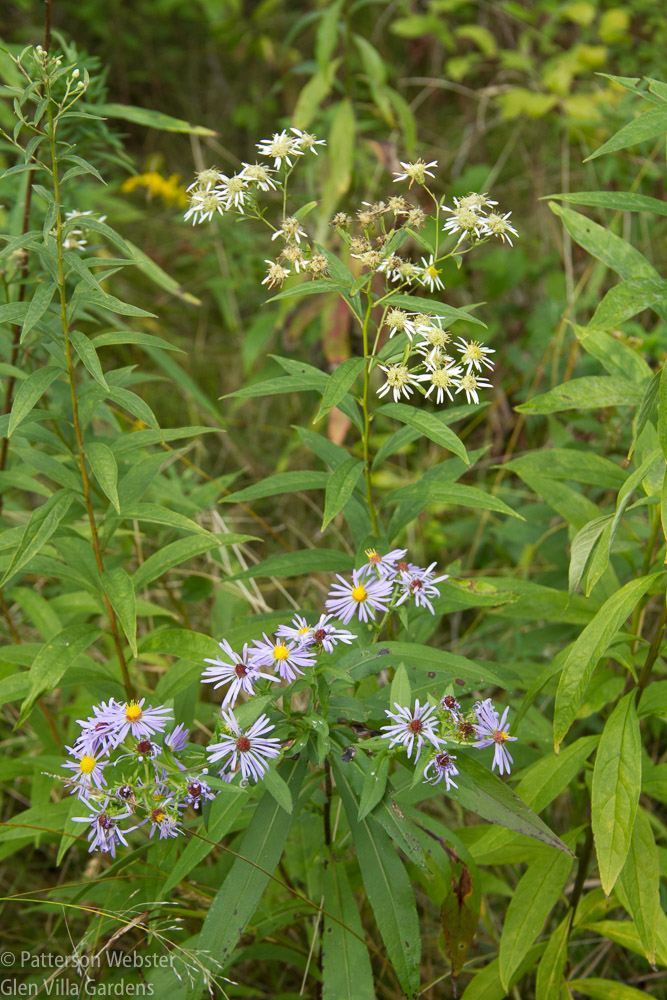
I’m sure that some people can tell one aster from another. I can’t. The white one may be Flat-topped white aster, Doellingeria umbellata.
A close-up view shows that the centres of the purple asters are either bright yellow or deep rusty red. I learned the reason only recently — the colour changes once the flower has been pollinated.

I don’t know which of the asters this one is. But notice the different coloured centres.
Colour changes in the woods are often more subtle than the obvious difference between the yellow and rusty red centres, but even subtle changes signal unmistakably that autumn is on its way.
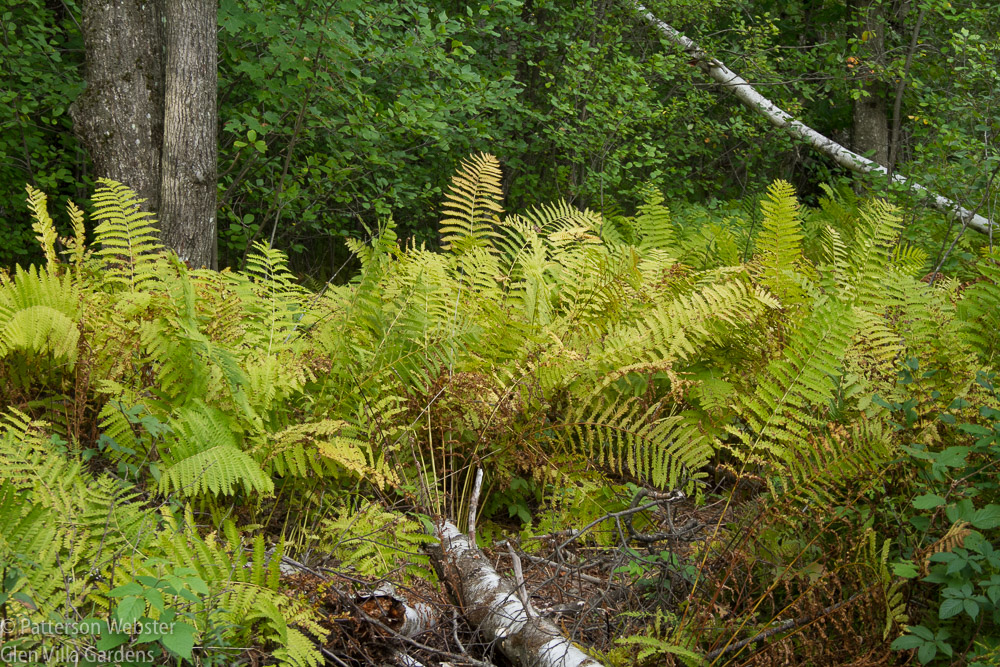
A few weeks ago these ferns were clear bright green, almost emerald. How would you describe the shade of green they are now?
There’s nothing subtle about autumn berries — their cheery red faces pop out among the leaf litter.
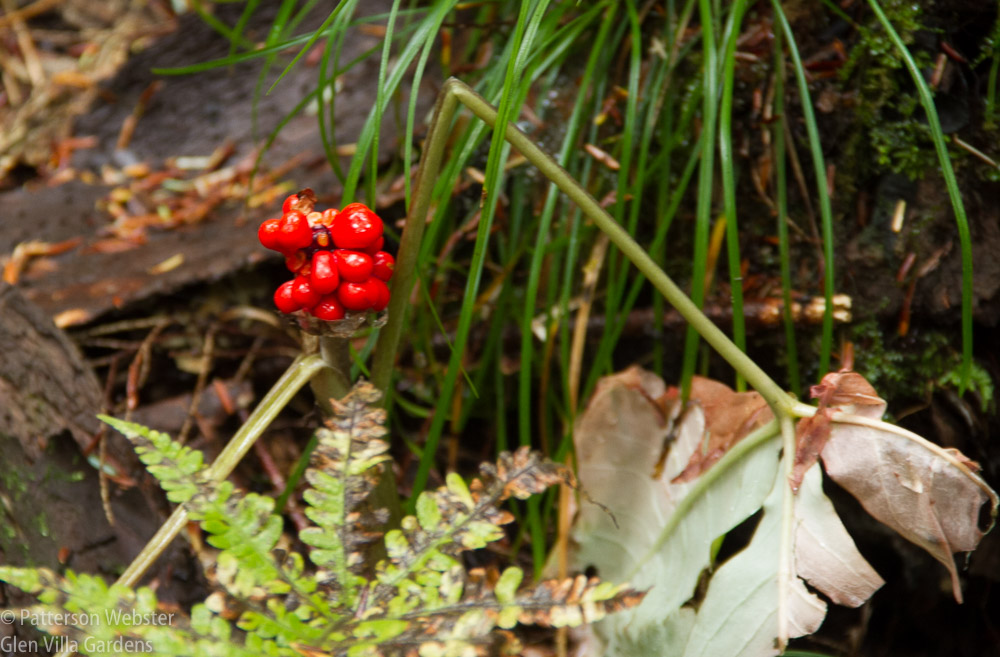
I think these berries are the fruit of Jack-in-the-Pulpit. Please tell me if I’m wrong.
In the garden proper, the approaching season is marked by colour changes in the Miscanthus sinensis ‘Malepartus’ that grows beside the Skating Pond. Its tall pink-tinged flower plumes are gradually turning silver as nights get cooler, moving through shades of red, orange and bronze along the way.

This plant is a vigorous grower and needs lots of space. It prefers full sun and a moist but well-drained soil. The plumes rise to 7 feet or more and sway gracefully in even the lightest breeze.
Also at the Skating Pond, the Calamagrostis ‘Karl Foerster’ that started as a soft feathery green is now the colour of wheat. It stands straight and tall, and will remain that way throughout the winter.

In front of the Calamagrostis is some Japanese blood grass (Imperata cylindrica ‘Red Baron’). I like the red tips on the grass. I only wish it would look this good earlier in the season.
Nearer the house, a dwarf horse chestnut tree is showing splotches of orange and peach. This tree is one of the first to colour up in the fall, and usually the very first to lose its leaves. In a normal year the branches are almost bare by the end of September but this year, all the leaves remain.
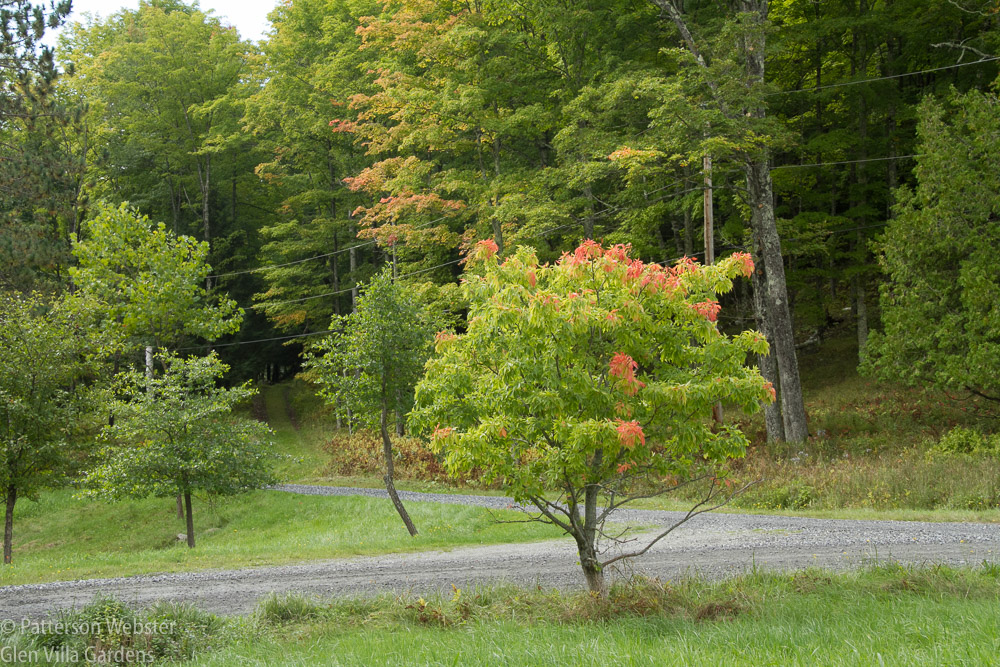
I think this horse chestnut is Aesculus flava. The blossoms in spring are pale in colour but I wouldn’t describe them as yellow, as the blooms of A. flava are meant to be.
These colour changes tell a clear story — even if autumn arrives a little later this year than usual, it will soon be here. That means that I will soon witness one of my favourite transformations, as the linden tree at the end of the Big Meadow moves from fresh green to buttery yellow. The first sign of what is to come appeared this week — a single pat of butter on the still vivid green.
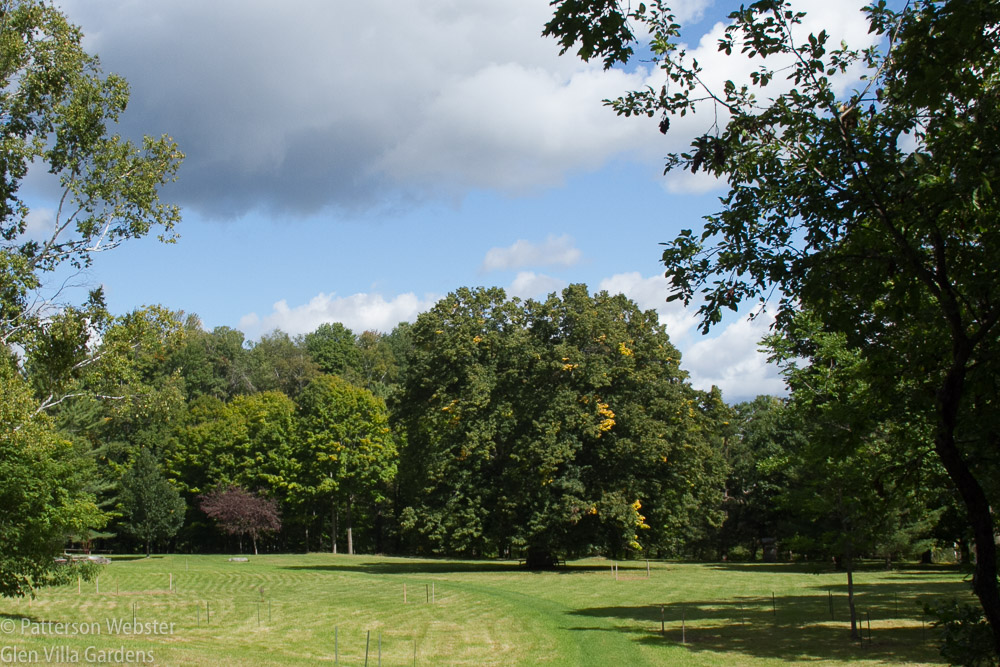
I took this photo last week, on September 24. The stakes show where I seeded wildflowers.
Gradually, the green loses its clarity, becoming more and more autumnal.
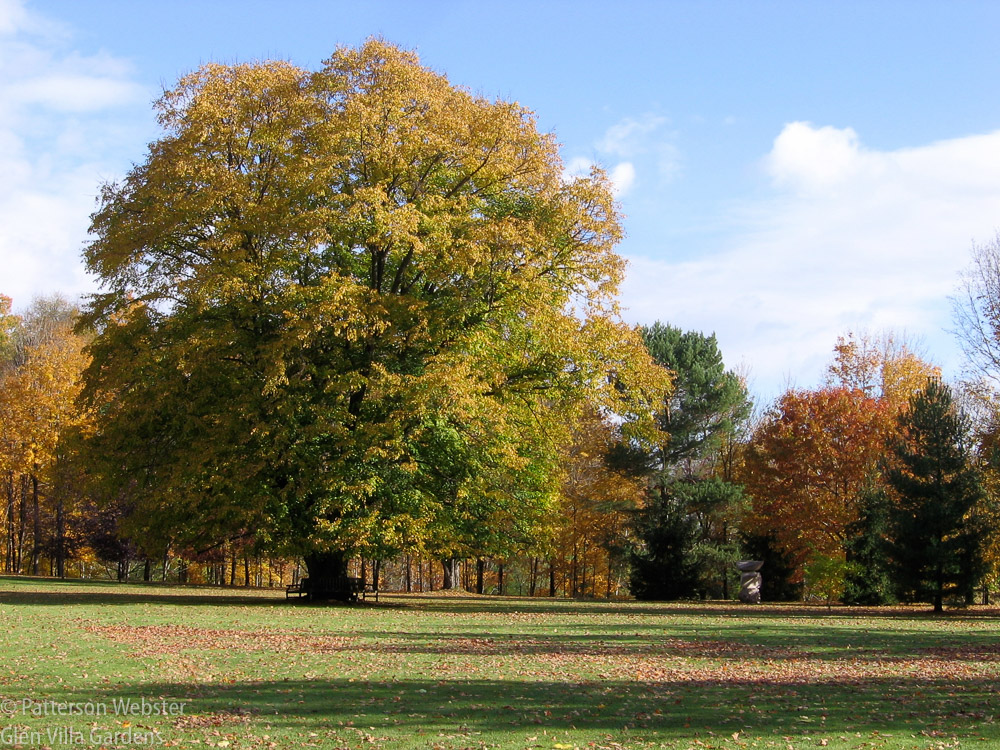
This photo is dated Oct. 20, 2007. Am I the only one who finds the colour here sad, as if it is tinged with regret?
Eventually the mix of colours disappears and the leaves become a single tone, a burst of sunshine that lights up my heart.
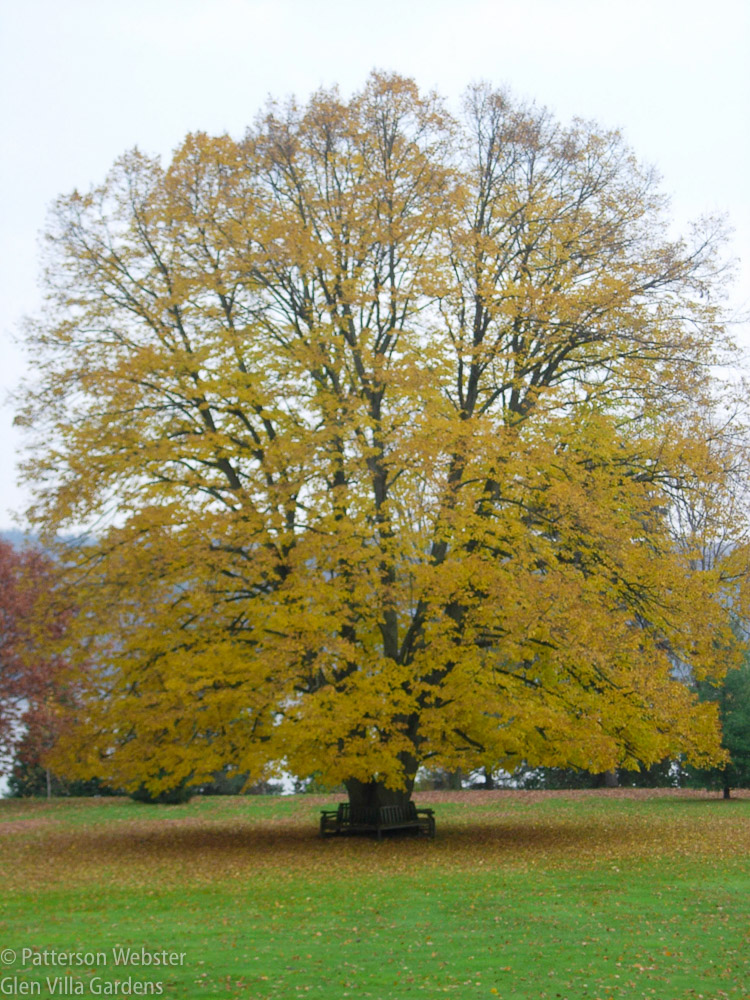
The colour didn’t shine to the max on the day I took this photo. I chose it, though, because of the date when I took it: Nov 6, 2005. So maybe autumn isn’t late this year after all.
Finally, of course, the tree becomes a skeleton of itself. But that skeleton holds its own appeal and its own promise, of another year to come.
Do you have a favourite sign of autumn? What is it?






Cool weather and wind have driven most of the Garry Oak (Quercus garryana) acorns from the trees. Time to pick them up and make food! I recently went down to Oak Harbor to gather acorns, and in the time since then, the pleasant aroma of drying acorns has inspired me to write a more comprehensive post about our native acorns.
A venerable specimen next to Sauvie Island (Oregon)
Also called Oregon White Oak, Garry Oaks are the only oak tree native to Washington and British Columbia. Oak woodlands and oak savannas are found in lowland valleys, gravely slopes, rocky outcrops, and dry plateaus from southern Vancouver Island southward, through western Washington and Oregon, and down to central California. At the northern end of the their range they are only found below about 2,000 feet, but as you move southward their range extends up to about 4,000 feet above sea level. Garry Oaks begin to mingle with Black Oaks (Quercus kelloggii) and Canyon Live Oaks (Quercus chrysolepis) at the south end of the Willamette Valley, and Blue Oaks (Quercus douglasii) and Valley Oaks (Quercus lobata) in Northern California, and then finally, Coast Live Oaks (Quercus agrifolia) near the Bay Area. You may also find Northern Red Oaks (Quercus rubra), Pin Oaks (Quercus palustris) and English Oaks (Quercus rubor) planted as street trees throughout the Pacific Northwest.
Blocky bark on an old Garry Oak
Garry oaks can reach great proportions when they grow in deep soils that are free from competing Douglas Firs. Of our western oaks, they are second in size only to Valley Oaks and occasionally reach 90 feet in height. However, on dry rocky soils and in areas with little precipitation, they take on a low scrubby form. Most commonly they are between 50 to 60 feet tall and 6 to 24 inches in diameter (See Sudworth’s “Forest Trees of the Pacific Northwest”). Garry Oak branches are often twisted and gnarled and their trunks can sprawl wildly. The mature bark is light grey with deep blocky fissures. Twigs are hairy when young. The leaves are 3.5 to 6.5 inches long, deeply lobed, and are shiny green on top and pale green below with somewhat of a leathery texture. They begin to fall around the end of September but take several months to drop all of their leaves.
The upper (left) and lower (right) surfaces of a Garry Oak leaf
Garry Oak acorns mature in one season. Acorns arise in groups of 1-3 and are relatively round, with the widest part at or slightly above the middle of the acorn. They are usually 1-1.25 inches long and 0.625-1 inch wide. Freshly fallen acorns will often still be green, but mature to a reddish brown. Caps are warty and only cover the upper 20% or less of the acorn.
A spectrum of Garry Oak acorn sizes (with a ruler showing cm)
Yikes, this acorn had a wriggly passenger!
The first wave of acorns begins to fall in early September, but these should be ignored by harvesters as they are almost always infected by acorn weevils. Ideally, the ground would then be burned or raked to clear away the diseased acorns in order to disrupt the acorn weevil reproductive cycle and facilitate faster picking when the mature acorns begin to drop. Typically healthy acorns fall from from late September to early November. Burning isn’t usually possible, so acorn harvesters need to know how to distinguish good acorns from bad. Sam Thayer devotes considerable attention to this topic in his book “Nature’s Garden”. To summarize, here are a few things to avoid: (1) acorns that still have caps, (2) acorns with small pin sized weevil exit holes in them, (3) acorns with shells that are separating from the disc at the top (where it attaches to the cap), (4) acorns with damaged vascular bundles in the disc (acorn weevils often enter the acorn through these soft vascular bundles), (5) acorns with dark spots, and (6) acorns that have sprouted but the sprout is dead.
I like to collect acorns with two different sized containers: a 3-4 quart basket that I keep with me (see Blog header photo), and a larger 4-5 gallon sized bucket that I keep in a central location. This allows me to devote more time to picking up acorns, and less time to traveling back and forth to my bucket.
http://arcadianabe.blogspot.ca/2012/11/how-to-eat-acorn.html
That’s quite a comment, Robert.
Acorns sound like gunshots hitting the glass table tops at the coffee shop and really a hard hat would put most at ease a little more!
I can hear them pinging… hard hat on order.
Summer is lingering here too. Believe it or not, it was 92 on Monday. I can hardly stand it anymore, but I guess Mother Nature is determined to keep her own timetable, not ours.
Your photo of the skating pond is pure poetry, with the contrast of ‘Karl’ standing tall above the irregular rocky outcrop and sensuous curves of the boardwalk and water line. Viewing the Linden in three stages is fun…I can almost feel the chill in the November air.
I’m in Vancouver where temperatures are perfect — almost fall-like! 92 is much too much for this time of year.
Glad you like the photos of the Skating Pond and the linden. I love looking back and seeing how the same scene changes, or doesn’t.
Enjoyed seeing your photos of the French garden near Bordeaux. It’s a new name for me.
I think you are right about the Jack-in-the-Pulpit. I think the asters in full bloom are my favorite sign of autumn. Also apple pie.
I’m with you on apple pie!
I agree the fading greens are tinged with regret, but once the greens have disappeared altogether one feels it behoves one to buckle down for the winter ahead and meet it head on. I think chartreuse, like the liqueur which can be either green or yellow, best describes the ferns, but I am completely taken with the wonderful pictures of your majestic linden tree, which I have always loved since I first set eyes on it and which trumps everything around it. It is like the custodian of everything else in the garden, the elephant matriarch watching with an unspoken concern the rest of her herd mature under the sure hand of your guidance.
My favourite sign of autumn is the distinct difference in the smell of the morning air – something that happens in a flash overnight. One day it is still summer; the next – autumn, without a doubt! Beautiful and sharp, but tinged with regret of another summer past.
I have never thought of the linden as an elephant matriarch but that will now stick as an image in my mind. And I agree totally about the smell of morning air. There is a crispness that is unmistakably autumnal. And while it may evoke nostalgia for what’s past, it is also energizing for what is to come… freezing cold winter snow and ice.